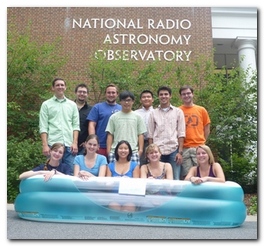Corrine Fletcher
Corrine Fletcher is a senior physics major who wanted to share her summer research experience at the National Radio Astronomy Observatory with other students. Read her account of a summer spent doing research.
“This past summer I had a Research Experience for Undergraduates (REU) with the National Radio Astronomy Observatory (NRAO) in Charlottesville, Virginia. My advisor was Violette Impellizzeri, a post doctoral fellow. I spent the summer using Extended Very Large Array (EVLA) data to confirm a detection of a 6.7 GHz methanol maser in the galaxy Markarian 3.
Over 800 6.7 GHz methanol masers have been found in our own galaxy and three have been found in the Large Magellanic Cloud. They are the strongest masers found in our galaxy and are found spatially near H2O and OH masers. Several surveys have been conducted to look for these methanol masers extragalactically. The surveys focused on galaxies with H2O and OH masers and with similar conditions to the methanol maser environments in the Milky Way. However none of these surveys were successful. In a previous post doctoral fellowship, my advisor used the Effelsburg telescope in Germany to conduct a survey for the 6.7 GHz methanol masers looking at completely different conditions. She surveyed ten galaxies that are all active galactic nuclei. This survey produced a detection of a 6.7 GHz methanol maser in absorption in NGC 3079 and a tentative detection in emission in Markarian 3. Markarian 3 was then observed with the EVLA to confirm the detection. Using this data, I flagged data and antennas, and did bandpass, amplitude and self calibration with a data reduction program called AIPS. I then created a cube and cleaned while imaging the data. Taking spectra of the data from different areas of the image allowed me to look for where the methanol maser was the strongest. The spectral line was found but still had a lot of noise. The signal to noise ratio gives the line a sigma of approximately 4 which means it is still a tentative detection. Since the spectral line was found at the same frequency as it was in the Effelsburg observation and the luminosities were similar the tentative detection is promising. However more observations and better resolution are needed to confirm the detection in the future. If the spectral line is confirmed the methanol maser would be the brightest maser detected and could create a different class of methanol masers. It could also show a different way for the masers to be pumped, possibly by the active galactic nuclei itself.
While at the REU I was also able to do some traveling. I attended the 12th Synthesis Imaging Workshop in Socorro, New Mexico, where I learned about interferometry, data reduction, imaging and much more. It was a wonderful networking opportunity and had many social events such as hiking, a pool party and barbeque and several dinner parties. We went on a tour of the EVLA and were able to walk on one of the antennas. I spent a weekend in Green Bank, West Virginia, where we used the Green Bank Telescope to do a few observing projects. This was another great learning and networking opportunity. I also did lots of sightseeing while in Virginia. The students I worked with were great people that helped me enjoy my REU and my summer to its fullest.”
